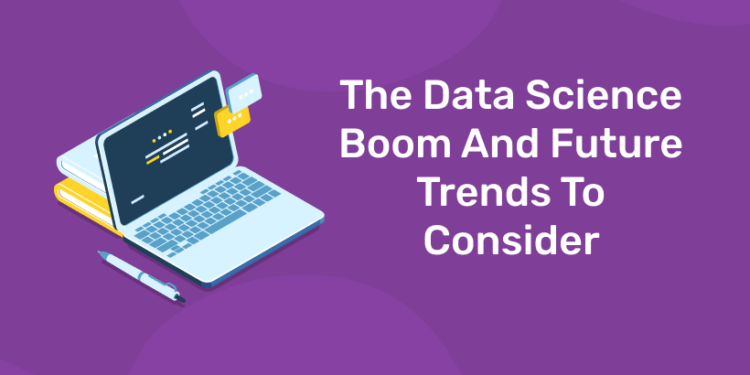Table of Contents
Technology is advancing rapidly, and it’s worth your while to ensure your tech team’s skills and knowledge remain relevant and ahead of the learning curve. Data science teams are composed of highly skilled and sought-after roles, and the expertise required to fill them is evolving as quickly as technology. These roles will continue to grow in importance and have become critical areas for organizations to expand and build upon.But what led to data science’s significance and growth in the workforce? Where does data science go from here? Here we’re going to take a closer look at the key factors that have influenced the growth of data science. Plus, some emerging data science trends to be on the lookout for in the future.
What’s contributing to the growth of data science?
Data science, in general, is an interdisciplinary field where scientific methods and processes are used to extract useful insights from data sets that can be used for applicable solutions.
This process is involved in almost everything we do, including the social media timelines we scroll through on our phones and decision-making processes in the workforce.
In short, data science is everywhere these days.
The relationship between data science and business revolves around organizations’ growing need for data-driven initiatives. This includes, but is not limited to, the need to leverage data science to make decisions that influence organizational strategy and direction. And this need isn’t solely confined to the high-tech or software realms.
In fact, there has been a massive growth in data-science jobs in the education, marketing, and manufacturing sectors. Business leaders want — and need — the best, most up-to-date resources at their disposal to help make decisions about the direction of their organizations. Data science delivers information backed by scientific data to help guide these decisions.
While many data scientists get their start in academia, many also develop their skills in the workplace. Cohen explains that those in academia have immense interest in data science and are often discovering new ways to analyze structured and unstructured data. There is a simultaneous need for data scientists in the workforce to analyze and leverage findings from the growing volume of data companies collect. Due to the dire need for more data science talent, companies are looking for more ways to expedite the growth of their data science departments, including collaborating with universities and students in fields that align with strong data science capabilities, while also developing data scientists from within their organizations.
Another factor contributing to the data-science boom is the growing interest that young adults are showing in this discipline, which has contributed to the “birth of data-science generation.” Additionally, the internet and social media have played a large role in pushing young adults — to consider careers in data science, whether it’s to work with social media algorithms directly or to find ways to use data science for advancements in other fields.
elevate your career with data science & ml course online !!
1: Which of the following algorithms is most suitable for classification tasks?
🚀 Start Coding Today! Enroll Now with Easy EMI Options. 💳✨
Equip yourself with in-demand skills to land top-tier roles in the data-driven world.
Start Learning Now with EMI OptionsFuture data science trends to consider
We now have a general sense of the factors that experts believe have contributed to the growth of data science. But where do we go from here?
Both Cohen and de Resende believe data science will continue to influence how businesses run their day-to-day operations. A notable advancement, in de Resende’s opinion, relates to time series and forecasting. Time-series analysis is a specific way of analyzing a sequence of data points collected over an interval of time, and forecasting relates to what’s going to happen in the future by analyzing the past and present. De Resende sees value in this capability and suggests companies focus on upskilling teams with these tools in the future.
Another emerging trend to consider is multivariable analysis, which Cohen refers to as a collection of analysis methods designed for large data sets with lots of variables. An example of this would be how a person’s overall health is determined. In this case, the multivariable analysis would take into consideration a number of variables — like calorie intake and how much someone exercises or sleeps — to get an accurate assessment of the individual’s overall health.
As an example of how this principle applies to the workplace, companies currently experiencing issues in the supply chain — an area that includes moving parts from multiple departments and locations — could potentially find the multivariable analysis useful.
Multivariable analysis’ stock increases further when considering how an individual or corporation is limited to testing only two variables at a time when they don’t utilize this approach Without multivariable analysis, an organization’s ability to categorize customers or examine marketplace trends would be highly compromised.
Multivariable analysis can provide insight into how businesses can best determine which variable or combinations of variables have the most potential to affect revenue and growth.
Enroll in our latest data science course and get free placement assistance in Entri app
Data Science Salary
Communicating all the productive observations and findings to the company stakeholders via data visualisation. The average data scientists salary is ₹698,412. An entry-level data scientist can earn around ₹500,000 per annum with less than one year of experience. Early level data scientists with 1 to 4 years experience get around ₹610,811 per annum.
Data Scientist Salary by Experience
According to O’Reilly’s 2016 Data Science Salary Survey, experience is one of the most important factors in a data scientist’s salary. For every year of experience, data science professionals make an average of $2,000 to $2,500 more.
A 2020 Burtch-Works study of data science salaries reported the latest salary trends based on experience:
Entry-level data scientist salary. Despite a recent influx of early-career professionals, the median starting salary for a data scientist remains high at $95,000.
Mid-level data scientist salary. The median salary for a mid-level data scientist is $130,000. If this data scientist is also in a managerial role, the median salary rises to $195,000.
Experienced data scientist salary. The median salary for experienced data science professionals is $165,000—while the median salary for experienced manager-level professionals is considerably higher at $250,000.
Are you aspiring for a booming career in IT? If YES, then dive in |
||
Full Stack Developer Course |
Python Programming Course |
Data Science and Machine Learning Course |
Job Roles in Data Science
1. Data Analyst
Data analysts are responsible for a variety of tasks including visualisation, munging, and processing of massive amounts of data. They also have to perform queries on the databases from time to time. One of the most important skills of a data analyst is optimization. This is because they have to create and modify algorithms that can be used to cull information from some of the biggest databases without corrupting the data.
2. Data Engineers
Data engineers build and test scalable Big Data ecosystems for the businesses so that the data scientists can run their algorithms on the data systems that are stable and highly optimized. Data engineers also update the existing systems with newer or upgraded versions of the current technologies to improve the efficiency of the databases.
3. Database Administrator
The job profile of a database administrator is pretty much self-explanatory- they are responsible for the proper functioning of all the databases of an enterprise and grant or revoke its services to the employees of the company depending on their requirements. They are also responsible for database backups and recoveries.
4. Machine Learning Engineer
Machine learning engineers are in high demand today. However, the job profile comes with its challenges. Apart from having in-depth knowledge in some of the most powerful technologies such as SQL, REST APIs, etc. machine learning engineers are also expected to perform A/B testing, build data pipelines, and implement common machine learning algorithms such as classification, clustering, etc.
5. Data Scientist
Data Scientists have to understand the challenges of business and offer the best solutions using data analysis and data processing. For instance, they are expected to perform predictive analysis and run a fine-toothed comb through an “unstructured/disorganized” data to offer actionable insights. They can also do this by identifying trends and patterns that can help the companies in making better decisions.
be a data scientist ! enroll to get free demo !!
6. Data Architect
A data architect creates the blueprints for data management so that the databases can be easily integrated, centralized, and protected with the best security measures. They also ensure that the data engineers have the best tools and systems to work with.
7. Statistician
A statistician, as the name suggests, has a sound understanding of statistical theories and data organization. Not only do they extract and offer valuable insights from the data clusters, but they also help create new methodologies for the engineers to apply.
8. Business Analyst
The role of bussiness analysts is slightly different than other data science jobs. While they do have a good understanding of how data-oriented technologies work and how to handle large volumes of data, they also separate the high-value data from the low-value data. In other words, they identify how the Big Data can be linked to actionable business insights for business growth.
9. Data and Analytics Manager
A data and analytics manager oversees the data science operations and assigns the duties to their team according to skills and expertise. Their strengths should include technologies like SAS, R, SQL, etc. and of course management.
| Our Other Courses | ||
| MEP Course | Quantity Surveying Course | Montessori Teachers Training Course |
| Performance Marketing Course | Practical Accounting Course | Yoga Teachers Training Course |












